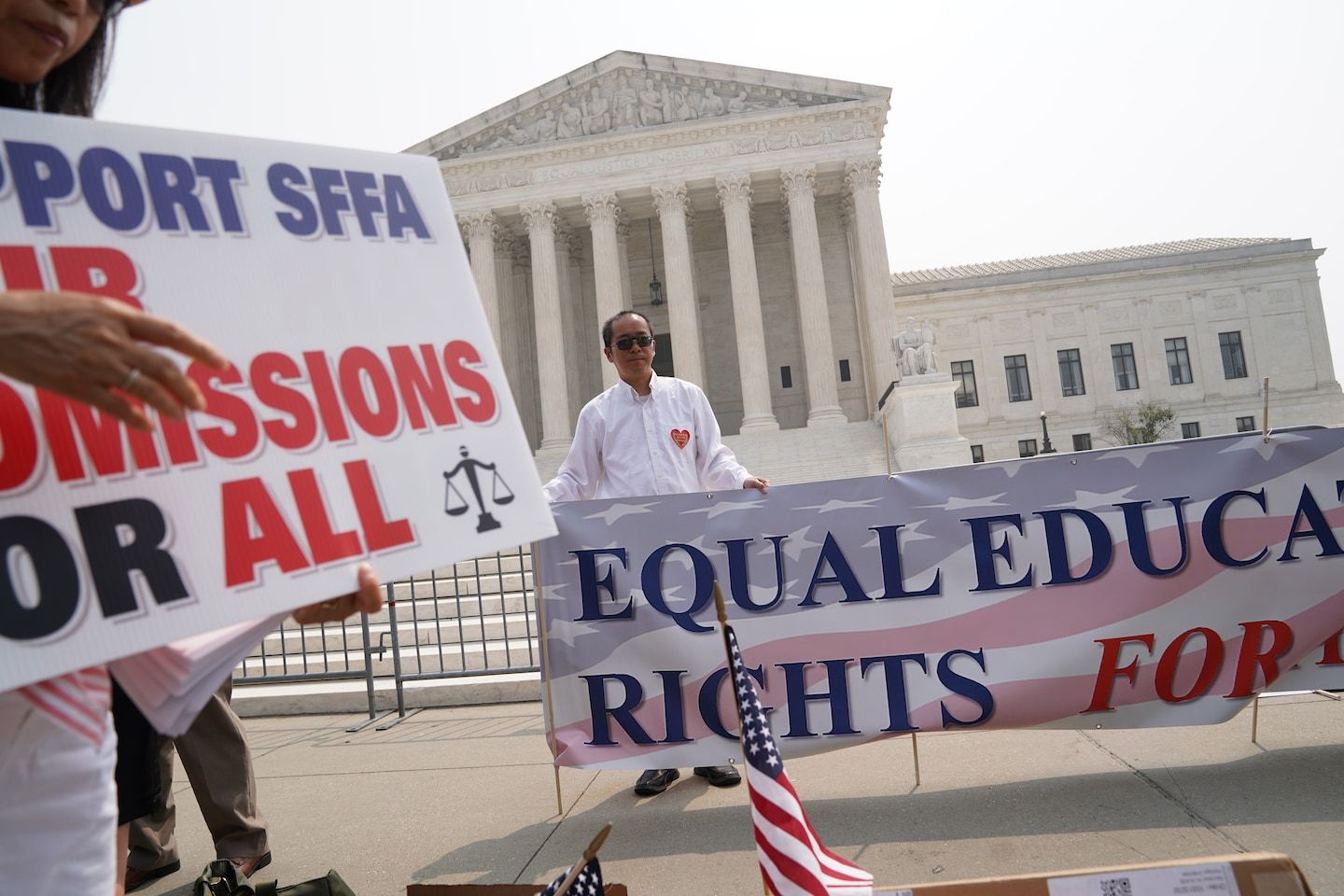Supreme Court restricts affirmative action in college admissions
Listen 8 min Comment on this story Comment Gift Article Share
The Supreme Court on Thursday held that admissions programs at Harvard and the University of North Carolina that relied in part on racial considerations violate the Constitution’s guarantee of equal protection, a historic ruling that will force a dramatic change in how the nation’s private and public universities select their students.
The votes split along ideological grounds, with Chief Justice John G. Roberts Jr. writing for the conservative members in the majority, and the liberals dissenting. While the ruling involved race-conscious programs at Harvard and UNC, it will affect virtually every college and university in the United States.
“The student must be treated based on his or her experiences as an individual — not on the basis of race,” Roberts wrote, joined by Justices Clarence Thomas, Samuel A. Alito Jr., Neil M. Gorsuch, Brett M. Kavanaugh and Amy Coney Barrett. “Many universities have for too long done just the opposite. And in doing so, they have concluded, wrongly, that the touchstone of an individual’s identity is not challenges bested, skills built, or lessons learned but the color of their skin. Our constitutional history does not tolerate that choice.”
Advertisement
Roberts said the admissions programs at Harvard and UNC “lack sufficiently focused and measurable objectives warranting the use of race, unavoidably employ race in a negative manner, involve racial stereotyping, and lack meaningful end points.”
But he added that “nothing in this opinion should be construed as prohibiting universities from considering an applicant’s discussion of how race affected his or her life, be it through discrimination, inspiration, or otherwise.”
It was the second time in as many terms that the court’s dominant conservative majority has undermined decades-old, landmark rulings. The votes were 6-to-3 in the University of North Carolina case and 6-to-2 in the Harvard case, with Justice Ketanji Brown Jackson recusing herself because she served on a board at Harvard.
Last year, the justices ended the guarantee of abortion rights that the high court found nearly 50 years ago in Roe v. Wade.
Advertisement
The court first approved the limited use of affirmative action in college admissions decisions 45 years ago, citing the importance of filling U.S. campuses with students from varied backgrounds.
In a lengthy dissent, Justice Sonia Sotomayor, the court’s lone Latina justice, wrote that it is “a disturbing feature of today’s decision that the Court does not even attempt to make the extraordinary showing required” to reverse precedent.
Sotomayor, who has said her own life is an example of how affirmative action programs can work, spoke at length from the bench on Thursday, a tactic justices use to mark their profound disagreement with a decision.
“Equal educational opportunity is a prerequisite to achieving racial equality in our Nation,” she wrote, joined by Jackson and Justice Elena Kagan.
“Today, this Court stands in the way and rolls back decades of precedent and momentous progress. It holds that race can no longer be used in a limited way in college admissions to achieve such critical benefits,” Sotomayor’s dissent said. “In so holding, the Court cements a superficial rule of colorblindness as a constitutional principle in an endemically segregated society where race has always mattered and continues to matter.”
Roberts’s majority opinion did not specifically say the court was overturning its precedent in Grutter v. Bollinger, the 2003 opinion that said universities could consider race as a factor in admission decisions to build a diverse student body.
Advertisement
But in his concurring opinion, Justice Clarence Thomas, a longtime opponent of affirmative action, wrote: “The Court’s opinion rightly makes clear that Grutter is, for all intents and purposes, overruled. And, it sees the universities’ admissions policies for what they are: rudderless, race-based preferences designed to ensure a particular racial mix in their entering classes.”
In a footnote, Roberts acknowledged that the federal government has argued there is a compelling interest in allowing the nation’s military academies to consider race in their admissions decisions. He held out the possibility that an argument could be considered in a future case, “in light of the potentially distinct interests that military academies may present.”
President Biden gave remarks on June 29 after the Supreme Court ruled to restrict affirmative action in college admissions. (Video: The Washington Post)
Leaders of elite private and public institutions have said they fear a dramatic drop in Black and Hispanic students if they are prohibited from giving any racial preference when making admissions decisions among qualified applicants.
Advertisement
President Biden appeared before reporters Thursday afternoon to express his strong disagreement with the decision. He defended affirmative action as a necessary tool, saying it enables colleges to admit a more diverse group of students who meet their admissions criteria.
“Discrimination still exists in America,” Biden said, repeating the phrase two more times for emphasis. He said he was directing the Education Department to “analyze what practices” at colleges and universities “help build a more inclusive and diverse student body and what practices hold that back.”
Thomas, who for decades was in the minority as the court upheld versions of affirmative action policies, took the unusual step of reading from his concurring opinion immediately after Roberts read the majority’s decision.
He said he was writing to make the case for a “color-blind” Constitution, although he acknowledged being “painfully aware of the social and economic ravages which have befallen my race and all who suffer discrimination.”
Advertisement
In his concurring opinion, Thomas directly engaged with Jackson, one of the court’s most liberal members, and the only other Black justice. In her view, he wrote, “almost all of life’s outcomes may be unhesitatingly ascribed to race.”
Jackson’s dissent, which she did not read from the bench, responds to what she called Thomas’s “prolonged attack.”
“With let-them-eat-cake obliviousness, today, the majority pulls the ripcord and announces ‘colorblindness for all’ by legal fiat,” Jackson wrote. “But deeming race irrelevant in law does not make it so in life.”
As recently as 2016, the court upheld an affirmative action program at the University of Texas, concluding for the third time that educational diversity justifies the consideration of race as one factor in admission decisions.
But Sotomayor is the only justice remaining on the court from that slim 4-3 majority. At the time, conservative activist Edward Blum, who brought previous challenges to the practice, was already working on new lawsuits he could present to a rebuilt court.
Advertisement
On Thursday, he declared victory.
“The polarizing, stigmatizing and unfair jurisprudence that allowed colleges and universities to use a student’s race and ethnicity as a factor to admit or reject them has been overruled,” Blum said in a statement. “Ending racial preferences in college admissions is an outcome that the vast majority of all races and ethnicities will celebrate.”
In the North Carolina case that was decided Thursday, Blum’s group Students for Fair Admissions said the flagship university’s policies discriminated against White and Asian applicants by giving preference to Black, Hispanic and Native American ones.
The case against Harvard, also decided Thursday, accused the university of discriminating against Asian American students by employing subjective standards to limit the numbers accepted.
Advertisement
Challengers say that under the equal protection clause, government-run universities such as UNC cannot use race as a factor in admissions decisions. Harvard is not subject to that constitutional clause, but must adhere to Title VI of the Civil Rights Act of 1964. That statute prohibits racial discrimination in the exclusion or denial of benefits under “any program or activity” that receives federal financial assistance.
At oral argument, several conservative justices repeatedly returned to the question of when — if ever — the consideration of race would no longer be necessary in college admissions. The justices pointed to the majority opinion in Grutter, in which Justice Sandra Day O’Connor’s opinion said racial preferences were not likely to be needed in 25 years.
That ruling 20 years ago was the first affirmative action decision by a Supreme Court on which White men did not make up a majority. The justices deciding this year’s affirmative action cases represent the most diverse Supreme Court in history.
Advertisement
Five of the nine justices had never cast a vote on the issue before this term, although some — notably Thomas and Sotomayor — have said affirmative action played a dramatic role in their lives. Those two justices came away from the experience with vividly different views.
Sotomayor, the court’s first Latina, has been the boldest defender of what she prefers to call “race-sensitive” admission policies and has referred to herself as the “perfect affirmative action child.” Without a boost, she has said, she likely never would have been transported from Bronx housing projects to the Ivy League. But she excelled as a top student at Princeton and Yale Law School once she got there.
Thomas, the second Black justice, countered that he felt affirmative action made his diploma from Yale Law practically worthless; he has been a fierce opponent of racial preferences in his three decades on the court. “Racial paternalism … can be as poisonous and pernicious as any other form of discrimination,” he has written.
The cases are Students for Fair Admissions, Inc. v. University of North Carolina, and Students for Fair Admissions, Inc. v. President and Fellows of Harvard College.
This is a developing story. It will be updated.
Gift this article Gift Article
Source: The Washington Post


